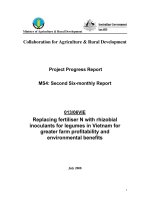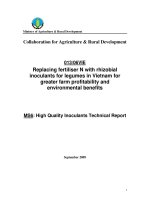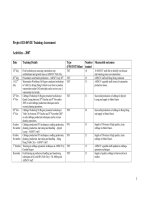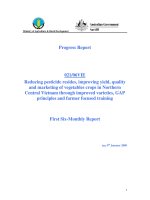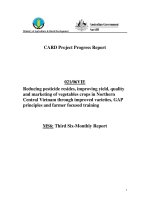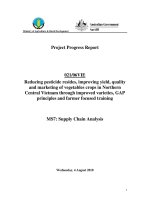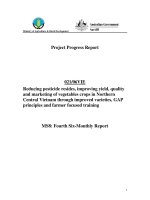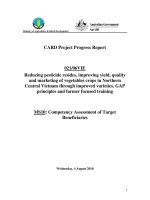Báo cáo khoa học nông nghiệp " Xác định và xác định các vấn đề ngành công nghiệp, nhu cầu và cơ hội Thông qua một cuộc khảo sát toàn diện và xem xét ngành công nghiệp xưởng cưa nông thôn " doc
Bạn đang xem bản rút gọn của tài liệu. Xem và tải ngay bản đầy đủ của tài liệu tại đây (805.56 KB, 61 trang )
1
MinistryofAgriculture&RuralDevelopment
CARDProjectReport
027/06/VIE
MS9+MS10:VALIDATIONANDCOMPLETION
REPORT
by
PeterVinden,PhilipBlackwellandPhanDucChien
August2010
2
VALIDATION AND COMPLETION REPORT 5
OBJECTIVES 5
Objective 1. Identify and define industry problems, needs and opportunities
through a comprehensive survey and review the rural sawmilling industry 5
Objective 2. Establish a facility for training and technology development 5
Objective 3. Develop and conduct training programs to improve operator
sawmilling and business skills for trainers and for mill operators 6
Objective 4. Investigate demonstrate and recommend more appropriate or
alternative technologies to improve industry performance. 6
Objective 5. Develop long-term strategies for industry development 7
Sustainability of project outcomes at institutional and operational levels 7
OUTPUTS 8
Extent to which project outputs and performance measures have been
achieved 8
Impact of project outcomes on target beneficiaries 11
Sustainability and coverage of benefits 12
ACTIVITIES : Detailed completion of activities 13
Justification for non completed activities 14
Quality of activity achievements 15
OBJECTIVE1 15
OBJECTIVE2 15
OBJECTIVE3 16
OBJECTIVE4 17
OBJECTIVE5 17
INPUTS 17
1. Policy Considerations: 19
THE DEVELOPMENT OF RURAL FOREST INDUSTRIES IN VIETNAM 19
Abstract 19
Background 19
The role of the National Forest Service 21
3
The conservation of tropical rain forests and native habitats 22
The establishment of “New Forests” to meet the needs and bridge the divide
between city dwellers and rural settlers 22
Consolidating supply of raw materials 23
Consolidating domestic demand for wood products 24
Research 24
Education and training in forestry, wood science, timber engineering and
furniture 26
Research training and education focus. 26
Strategies to Assist Rural Sawmill Development in Vietnam 27
2. Appendix: 32
THE ESTABLISHMENT OF “NEW FORESTS” IN VIETNAM 32
Summary 32
Background. 32
New Forests 33
3. Appendix: 37
FOREST INDUSTRIES 37
2.1 Energy required for processing 38
2.2 The link between trees, wood and architecture 40
2.3 The popularity of forestry and foresters 40
2.4 Conclusions 41
4. Appendix: 42
FOREST INDUSTRIES RESEARCH 42
Background 42
Research program 42
Program 1. INNOVATION 44
Carbon positive design (CPD); 44
Design for recycling, reuse and reassembly 44
Design durability 44
Program 2 FUNDAMENTAL SCIENCE 45
Biochemical pathways for lignin, cellulose and hemicellulose biosynthesis 45
Lignocellulose fibre composition 45
Lignocellulose interactions 45
4
Chemical and physical modification of wood fibre 45
Program 3: NOVEL TECHNOLOGIES 46
Low temperature fast pyrolysis 46
Modification of bark and in situ tannin fixation to provide a physical and
chemical sieve for waste capture of proteins, heavy metals and oil for
recycling 46
Microwave modification of biomass 46
Plant-fibre polymer composites 46
Sawmilling, drying and preservation and furniture manufacture 47
Program 4. Education and knowledge transfer 47
PhD student research projects 48
Masters course work programs 48
Software aids in Design 48
Policy development programs incorporating Carbon Positive Design 48
Patent protection of innovative technologies 49
Potential research partners 49
Potential End user organizations 49
5. Appendix: 50
CONSOLIDATING TRAINING AND EDUCATION 50
4.1 Training requirements 50
Survey of industry attitudes to training 50
4.2 Training Program Structure 52
6. Appendix: 53
RURAL SAWMILL DEVELOPMENT IN VIETNAM 53
Conclusions 58
5
VALIDATION AND COMPLETION REPORT
Thisreportprovidesasummaryofprojectachievementspresentedaccording toCARDprotocols
and final recommendations to ensure ongoing development of rural forest industries in
Vietnam.
OBJECTIVES
• Extenttowhichprojectobjectivesandperformancemeasureshavebeenachieved.
Objective 1. Identify and define industry problems, needs and opportunities
through a comprehensive survey and review the rural sawmilling industry.
This has been achieved by establishing an inception meeting with stakeholders from industry,
educationandresearchinstitutes,government, bilateralandmultilateralaidagencies.Detailed
questionnaires were developed with input from the inception committee. Vietnamese project
participantsattendedatrainingprograminAustraliatodevelopandrefinesurveymethodology
and review appropriate
wood processing technologies. The industry survey and review was
undertakenbyajointVietnamese/Australianteaminrepr esentativeprovinces,incooperation
withprovincialDepartmentsofAgricultureandRuralDevelopment.
The survey was conducted in the form of a participatory rural appraisal (PRA). Individual mills
werevisitedandthefollowing
typesofinformationsoughtfromowners:logvolumeinput,sawn
wood output and grades, price and cost data, end‐use markets, equipment used, employee
statistics,problemsidentifiedbyowners,andowner’sviewsondevelopmentneedsofindustry.
A complementary survey was also undertaken to include plantation growers to assess their
views
on markets and prices and sawn timber buyers to assess their views on sawn wood
products purchased. The results were collated and a detailed report publish ed. The findings
weresupplementedbyaseparatereportoutliningthecurrentstateofdevelopmentofforestry
andtheforestindustriesinVietnam, theircontribution
totheeconomyandruraldevelopment
andpotentialtogrowinthefuture.Thesereportswereusedasbackgroundtodevelopingmore
detailed reports on individual sectors of the industry including sawmilling, wood drying,
preservation, forest industries education and training, research and extension. Each of these
reportshasbeencompleted.
Objective 2. Establish a facility for training and technology development
Althoughthisprojectdidnotdirectlyestablishatrainingfacility,ithasbeeninstrumentalinthe
trainingofVietnameseresearchersandtrainersinWoodScienceandSawmilling.Thesepeople
haveusedthistrainingin theeducationofsawmillersandstudentsaspartoftheextension work
or training activities. The Lucas
portable sawmill will further be used in the development of
training programs to teach on the quality advantages of quarter‐sawn timber over the
conventionalflatsawnmethod.
The Vocational School for Agriculture and Rural Development in Central Vietnam has
undertakenthetrainingandisnowusingthematerialwith
theirstudents.Thetrainingfacilityin
6
Dai Lai hasbeen involvedin the training andextension workwith the ruralsawmillers in their
region.
This exte nsion program will continue as the researchers who have been trained are used in
workshopsandasaresourceforforestgrowersandfarmers.
The establis hment of a facility was extensively discussed
within the project team and the
recommendation was that a stand alone facility would be expensive to establish and run plus
havelimitednumberofpeoplewhowouldusethefacilitythereforethetrainingoftrainerswas
consideredtobemorebeneficialandfittheprojectbudget.
Objective 3. Develop and conduct training programs to improve operator
sawmilling and business skills for trainers and for mill operators
Structured programs of sawmill training for rural communities were developed based on the
needsanalysisidentifiedinthesurveyofruralsawmills.Thefocusforthistraini ngwastechnical
ratherthantraininginbusinessskills,sinceitwasanticipatedthatthiswastheareaofgreatest
need. However, participants have identified
a need for training in business skills and this has
been addressed in detailed curriculum developed for future courses. Course materials in the
formofTechnicalNotesandoverheadsweredevelopedforthesecourses.A“trainthetrain er”
coursewasheldinAustraliaforVietnameseparticipantsandagaininVietnam.
Foursessionsof
rural training have been completed successfully by the CARD project and feed‐back obtained
fromcourseparticipants.
Objective 4. Investigate demonstrate and recommend more appropriate or
alternative technologies to improve industry performance.
Detailed reports on each sector of the forest industries have been completed and
recommendations made in relation to the suitability of alternative technologies to improve
industry performance. Separate reports are provided on sawmilling, drying and preservation.
The central question is whether the small horizon tal band saw and vertical band‐saw can
be
replaced with more automated facilities to provide centralised processing. There is a chasm
between the costs and operational needs of these small sawmills versus the next level of
sophistication; aninvestment of $4,000 for the current rural sawmillversus 1‐2million for the
cheapestlevelofautomatedsawmill
(forexampletheHEWsawmill).Automationbrings withit
the need for continuously available wood raw material of high quality, and a substantial
improvementinworkerproductivityalbeitatthe expenseofjobs.Valueaddingandexpanding
theutilityofwood throughpreservation andcorrectdrying usingappropriate technologiesare
recommended
instead of focusing on the replacement of small rural sawmills. The small rural
sawmill provides infinite flexibility in providing primary conversion of the log. None‐the‐less
substantial improvements in the operation of small rural mills can be achieved through a
program of sa wmill improvement. This report summarises recommendations from
individual
industrysectorsinrecommendingspecifictechnologiesthatcanimprovethelongtermviability
oftheindustry.
7
Objective 5. Develop long-term strategies for industry development
There has been an acceleration in the establishment of fast growing plantations of mostly
Australianspecies (acacia’sandeucalypts).This hashadvery desirableimpacts inreducin g the
exploitationof nativeforests.A verysubstantialrural sawmillingindustryhas developed based
onthisrawmaterial thathas hadasignificantimpact
onruralprosperityandthe alleviationof
poverty.At thesametime theindustry has meta growingneed forconstructionandfurniture
timbers in the domestic market. However, the almost exponential proliferation of small
inefficientmillsusing lowqualityroundwoodwith scantregard forqualityor thetechnological
needs
ofend‐usingindustriessuchasfurniturehasresultedinsubstantialovercapacity,market
uncertainties and haphazard raw material supply. There are currently very limited means for
researchingandestablishingnewtechnologyorupgradingtheskillsoftheworkforce.
Detailed analysis of the sector provides a clear picture of an
industry at a cross‐road that will
either see a substantial decline in its fortunes or (depending on Government policy) and the
futureroleoftheVietnamForestService,asubstantialexpansioninactivity,particularlyinvalue
adding in domestic furniture and construction, with employment and prosperity for the rural
sector.
Long‐term strategies are developed in this report to improve productivity of rural sawmilling
through new technologies that are relevant to expanding value adding. Analysis of the sector
identifies its importance and the need for long term policies directed towards improving the
availability and quality of plantation grown logs specifically
for the rural sector. Training,
education, research and e xtension cannot be looked at in isolation. Similarly long term forest
operations relating to maintaining biodiversity, conservation of rare and endangered species,
reclamation of degraded land improving water quality and the provision of recreational areas
and conservation of areas of historical significance
etc, should not substitute or dimi nish
responsibility for integrating areas of production forests that can in the future maintain the
viability of rural areas and provide rural industries of the future. Thus the long term strategy
adopted in this report unashamedly recommends the involvement of Government and the
Vietnam Forest Service
as an active player in the production of commercial plantations
specifically to meet the needs of rural industries. There will be counter arguments that
productionforestsarenotapublicutilityandassuchshouldnotbea governmentactivity,that
it should be left to the private sector. For
Vietnam’s rural poor such an argument is hardly
relevant.Thestrategydevelopedinthisreportisforthedevelopmentof“NewForests”,forests
thataregrownascloseaspossibletolargecitiestomeetamultipleofobjectives;toprovidean
interfacebetweentheurbandwellerandruralpoor.Research
investmentintoforestindustries
isexpandedtofocusonbestinternationalpracticeandglobalissuessuchasgreenhouseandthe
rolethatforestindustries canplayinreducingthecarbonfootprintthroughsubstitutingthe use
of non‐renewable resources such as steel and oil, whilst at the same time
providing the
infrastructureneededtoassisttheadoptionofnewtechnologiesbytheruralsector.
Sustainability of project outcomes at institutional and operational levels
The Vietnam Forest Service is thelogical institution thatshould be givenlong‐term carriageof
the aims of improving operator skills and techno logy in small rural sawmills in Vietnam.
Recommendations are provided in this report for the expansion and reorganisation of Forest
8
Service activities to service these needs, through the provision of training programs, research
and extension. The recommendations are fairly radical in nature primarily because current
servicing of therural sectoris almostcompletely absent.Thein frastructure (trainedpersonnel
and equipment) needed for servicing thesector is also almost non‐existent. The
CARDproject
has been successful in identifying how important the rural industry is and will become in
meeting dom estic needs for furniture and construction and the future prosperity of the rural
sector. The CARD project has provided a framework for research, education, training and
extensionas wellasmuch of
theresources(technicalnotesand overheads)needed toprovide
ongoing training. The sustainability of future outcomes in this sector will depend on how
successfullythe ForestSer vicecanrealign itsobjectivesin relationto theruralsector andhow
effectiveitismarshallingnewresourcestoe xpandandtraintheworkforce
needed
OUTPUTS
Extent to which project outputs and performance measures have been achieved
Alloutputs,milestonesanddeliverablesasdefinedintheoriginalproposalhavebeenachieved
and are highlighted in table 1.Delays were experienced in meeting most of the completion
dates.This aroseprimarilyasaresultofdelaysfromtheUniversityofMelbourneinsigningthe
originalagreement.Thisresultedinunplanned
re‐sequencingofactivities.Theunfortunateand
untimely death of John Fryer who championed the project also left an enormous operational
gap for the project.John was responsible for managing project logistics and activities in
Vietnam.PhilipBlackwellwasappointedasavolunteerreplacementforJohnFryerandhasbeen
locatedwithin theVietnam Forest Service(Hanoi). Thisfilled thegapexperiencedin managing
project activities. Further delays arose from unanticipated internalchangesand reorganisation
withintheUniversityofMelbourneaffectingtheavailabilityofstaff
The objective of installing a horizontal bandsaw was changed instead to a vertical bandsaw
followinga
reviewoftheefficiencyoftherelativetechnologiesinsawingsmalllogs.Aninternet
repositoryofalltechnicalreportsrelatingtotheCARDprojectwasestablishedtoassisttransfer
and review of documents between Australia and Vietnam. It was decided that making the
internetconnectionavailablepubli cally shouldwaituntil:
• AlldocumentshadbeentranslatedintoVietnamese
• CARDhadapprovedandacceptedeachofthedocuments
• Future responsibility for on going extension following completion of the CARD project
hadbeenfinalised.Thisactivityisdiscussedbelow.
9
Table 1. Milestones and Deliverables
Output
Milestones
Milestonedescription Deliverables: comments
1. Contractsigning Contractcompleted completed
2 6‐monthlyprogressreports
andprojectcompletionreport
Fourreports,acceptedby
AusAID
3,6monthly
reportsand1
completion
report
completed
Objective1:toidentify&defineindustryproblemsandopportunitiesthrougha
comprehensivesurveyandreviewtheruralsaw‐millingindustry
Outcome
milestone
Milestone description
Deliverables comments
Meetingofinterestedparties Inceptionmeetingorganised
andnetworkoforganizations
andcompaniesinvolvedinthe
projectestablished.
completed
FormationoftheprojectSteering
Committee
SteeringCommittee
established;questionnaire
designedandsurveyoperations
designed.
completed
BaselineSurveyundertakenin
South,CentralandNorth
Vietnam
Draftreportcompleted completed
Output1.
Meetingofstakeholdersto
finaliserecommendationsand
reviewobjectives.
Surveyreportcompletedand
recommendationsfinalised
completed
Objective2:establishafacilityfortrainingandtechnologydevelopment
Evaluateandpurchase
portablemillfortraining
Portablemilloperational Changeddesignof
milltofocusonLucas
sawmillratherthan
horizontalbandsaw
Electronicwebpagedesigned
forclustergroups
Webpageoperational Confidentialweb‐
pagetoholdall
technicalreports
completed.
Blocktrainingcoursesand
datesdefinedandadvertised
totargetaudience.
Brochurescompletedand
disseminated
completed
Output2.
Meetingofstakeholdersto
reviewprogressand
objectives.
Reportincluding
recommendationsforfurther
conductofproject
completed
10
Objective3:Developtrainingprogramstoimprovesaw‐millingandbusinessskillsfortrainers
andformilloperators
Output3 Blocktrainingcoursesfor
trainersdefinedandheld
inAustralia.
Blocktrainingcoursesfor
trainersinAustralia
completedand
evaluated.Training
handbookfortrainers
drafted.
Completed.Handbookproviding
Technicalnotesandoverheads
Output4. Blocktrainingcoursesfor
trainersheldinVietnam
Blocktrainingcoursesfor
trainerscompletedin
Vietnamandevaluated.
Traininghandbookfor
trainersdrafted.
completed
Output5. Coursedesignforblock
deliveryinCentral
Vietnamandlecture
notescompleted.
Coursenotestranslated
intoVietnamese.
completed
Output6. Firsttrainingcoursefor
sawmillersinVietnam
Courseconductedand
evaluated,evaluation
report
completed
Output7 Meetingofstakeholders
toreviewcoursenote
materialandtrainingthe
trainer’smanual
Reviewreportcirculated
tostakeholders
Technicalnotescompletedand
arenowbeingtranslatedinto
Vietnamese.Meetingwith
stakeholdersdelayeduntil
translationiscompleted
Output8 longtermimpactand
benefitsassessmentof
trainingonselectedsaw
millers
Assessmentreport
consideredbyadvisory
committee,
recommendationsfor
furthertraining
directions
Detailedrecommendations
completedinfinalValidationand
completionreport.
Meetingtobeheldwith
stakeholdersoncetranslationis
completed
Objective4:investigate,demonstrateandrecommendonmoreappropriateoralternative
technologiestoimproveindustryperformance.
Output9.
Evaluatetechniquesforimproving
theperformanceofVietnamese
manufacturedhorizontalbandsaws.
Portablesawmill
modified&tested.
Technicalreport
completed
Verticalbandsaw
substitutedfor
horizontalbandsaw
Output10.
Determineoptimumdrying
parametersforkeyplantation
species.
Technicalreport
completed
completed
Output11.
Establishhousekeepingprotocolsfor
reducingfungaldegradelogsand
sawntimber.
Technicalreport
completed
completed
Output12.
Reviewtechnologiesandneedfor
preservativetreatment
Technicalreport
completed
completed
Output13.
Comparetechnologyneedsfor
centralversusdecentralised
sawmilling.
Technicalreport
completed
completed
11
Objective5:developlongtermstrategiesforindustrydevelopment
Output14. Comparetechnologyneedsfor
centralversusdecentralised
sawmilling,andpolicy
implications
Technicalreport
completed
completed
Output15. Identifydomesticmarket
requirementsforsawntimber
(sizesgrades),evaluatequality
Technicalreport
completed
completed
Output16. Identifyfuturetechnologyand
trainingneeds
Technicalreport
completed
completed
Output17. seminarwithstakeholders;
reviewfindingsanddraftfinal
reporttoAusAIDand
recommendationstoMARD
Draftreport
completed
Draftreportcompleted.
Seminar/Workshopto
considerprojectfindings
andreportsbeheldata
reporthandingover
ceremony.
Impact of project outcomes on target beneficiaries
The rural sawmill survey report together with the report reviewing the current and future
prospects for forest industries in Vietnam highlight the very significant importance of this
industry to the economy of Vietnam and future well being of rural populations. Prior to
undertaking the survey therewasvery littleinformation available
on ruralsawmilling.Analysis
of the survey and it reporting has articulated a clear picture of the state of the industry, its
strengths,weaknesses,opportunitiesandthreatsandavisionforhowtheindustrycandevelop
inthefuture.
TheCARDprojecthastrainedacoreteamofVietnamesescientists
inthetechnologies(current
andfuture)thatwillassisttheindustrytodevelop.Visitstotheseindustriesduringtheconduct
ofthesurveyhasprovidedanauditoftheiroperations(asmightbeundertakenduringasawmill
improvement program). The opportunity for providing advice on improving the operational
efficiencyofthe
sawmill,dryingortreatmentfacilitywastakentogetherwithon‐sitetrainingof
Vietnamresearchersintheapplicationofsawmillimprovementprograms.
Vietnamese research staff attended an intensive training program at the School of Forest and
Ecosystem Science, Creswick campus, Australia and learned about the hands on operation of
sawmills
and the alleviation of growth stresses; the efficient operation of kilns and treatment
plant,qualitycontrolmonitoringoffinis hed products,valueaddedmanufacturingandnewlow
tech technologies to assist expansion of sawmilling operations into value adding. The same
Vietnamese staffs participated in the development of training courses and have actively
participated in the training of rural communities in Vietnam in these aspects of wood
technology.
Detailed analysis of specific sectors (sawmilling, drying and preservation) has highlighted the
technical needs of these sectors, the technology options available and the cost / benefits of
adoptingparticulartechnologies.Veryspecificrecommenda tionshavebeen
providedineachof
12
these sectors as to the best technical and economic (low risk) options available for expanding
intovalueadding.
The haphazard and exponential proliferation of small sawmills has identified the potential for
this industry to be self starting and sustainable with appropriate technologies and local
investment. However, the survey also identifies the
fragility of self help initiatives that are
dependenton continuingraw materialsupplies (albeitoflow quality)andthescantavailability
of knowledge and technical skills needed to value‐add sawn timber output. Clear policy
decisions and action is needed to ensure continuing raw material supply of improved quality,
together
with appropriate training and the availability of appropriate technologies for value
adding that can betaken up through the sameprocess of selfhelp. At thesame time training
needstobeprovidedthatwillupgradeskillsandawarenessofOH&Sissues.
Training materials and infr astructure have been developed and tailored
to the requirements
identifiedinthesurvey.Implementationofpolicyrecommendationsfromthereportswillhavea
major impact on the long term development of the industry and future development of rural
communities.
The most significant outcome of the project is that rural communities have articulated their
perceptionofthe
futureneedsoftheirsector,theiraspirationsandfearsforthefutureaswell
as their vision of what potentially could develop in terms of expanding their activity. To a
greaterextentthesawmillingcommunityhas articulatedoptimisminthelight ofopportunities
thatareavailableindevelopingproductsandmarkets.
TheprojecthasprovidedtheForestServicewithablueprintorplanthatis relativelylowriskin
itsimplementation,butwhichrecogniseswhathasbeenachievedbytheruralcommunityinlow
tech processing of plantation logs and builds onthis througha “New Forests”strategy and an
innovativeprogramofresearch,trainingeducationandout‐reach.
Sustainability and coverage of benefits
The rural sawmilling industry and has grown exponentially over the last 10 years utilising
resources that have been self generated by rural peoplesthroughout Vietnam. It is an
incredible success story of international proportions where the right (home developed)
technology,availableatan affordablepricehascoincidedwiththeavailabilityof
affordableraw
materialandmarkets.Theopportunitynowexitsforthegovernmenttoprovideahelpinghand
to reduce the risks associated with taking on a logical evolutionary role in moving to value
adding, not througha processof financialhandouts (localcommunities havedemonstrate d an
abilityfor selfhelp)
butsimply throughproviding securityinraw material availability, together
withcontinuationofthetraining,educationresearchandextensionstartedbytheCARDproject,
to provide skills, infrastructure and appropriate technologies that will meet the aspirations of
themanymillswanting totakethisnextstep.
Rural forest industries are very
vulnerable to policy changes. Future deve lopment of the
industry needsto be underpinned orchampioned bya single governmentdepartment, inthis
case most appropriately the Vietnam Forest Service. A logical step in providing long term
securityofrawmaterialsupplyistheadoptionofa“NewForest”policy
(outlinedinthis report).
13
Adoptionofsuchapolicywillnotonlybenefittheruralpoor(byprovidingemploymentandraw
material), but alsothe city dwellers whoin the futureeconomic prosperity ofVietnam will be
lookingfor“green”areasofrecreationclosetothecity.Thusthepotentialcoverageofben efits
will embrace
not only the rural population of Vietnam but also city dwellers that aspire to
enjoyinggreenareaswithintraindistancefrommajorcities.
Adoption of the recommendations in this report will need major policy initiatives focussed on
the Vietnam Forest Service. Very clearly the adoption of such broad reaching policy
changes
needs very clear articulation of the findings this CARD project. Thus the objective is to hold a
final debriefing workshop after all translation of project reports has been completed. A
conferencestylepresentationofreportfindingswill beprovidedasaformalcompletiontothe
CARDproject.Thiswillbe
followedbyadetailedworkshopanalysisofreportrecommendations
andtransferoffutureinitiativeoftheprojecttothesteering committee.
ACTIVITIES : Detailed completion of activities
The7projectactivitiesdefinedatthecommencementoftheprojectarehighlightedin table2.
All activities have been completed. The death of John Fryer left a gap in managing project
activitiesinVietnam.However,theappointmentofPhillipBlackwell(anexpe rtinsawmilling)to
a volunteerposition to oversee
CARDproject activities has ensured that allthe activities have
been brought to a successful conclusion. The first activity‐development of the survey
questionnaire through the inception meeting of stakeholders meeting was characterised by
enormous enthusiasm and input into defining the survey questionnaire. No problems were
experienced in conducting the
survey or summarising the results. The data base provides a
detailed snapshot of an industry that has grown exponentially and is now looking at vertical
integrationtoexpanditsactivitiesintovalueaddedprocessing.
PhilBlackwellhaschampionedtheestablishmentofsaw‐milltrainingfacilities.Theoriginalaim
was to establish
a horizontal band saw. Historically the original horizontal bandsaw was
developedforsawinglargerdiameternativelogsandhassincebeenadaptedforusewithsmall
diameteracacialogs.Astheprojectteambecamemorefamiliarwithoperationofthehorizontal
bad‐ saw, it became clear that given the quality
and small diameter of acacia logs that the
industry would be better served with a vertical band saw. This also became obvious when
interviewing those mills that hadadopted vertical band‐sawing ratherhorizontal band‐sawing.
ThischangewasagreedtobyCARD.
Early on in the development of the project
there was some aspiration to find the next
evolutionary stepin sawing.To move from smallscale horizontal sawing inthe backyard to a
moresophisticatedsystemssimilarinprincipletotheHEWsawingtechnology.Inundertakinga
detailedreviewofsawmillingtechnologiesincludingtheHEWsawingtechnology,it
isclearthat
theleap in technologybrings withit acostin capitaljump from$3000to between$1‐2mi llion
and the additionalrequirements for continuity in supply ofhigh quality raw material. There is
obviously a place for a very limited number of such automated mills in Vietnam. On
bal a nce
however, it is not possible to substitute current te chnology without severe impacts on rural
employmentthatintheendwouldtendtobecounterproductive.However,muchcanbedone
througha sawmillimprovementprogram toimprove thesafeoperation ofcurrent equipment.
Atthesametimethereareappropriate
technologiesthatcanbeusedforvalueaddingsuchas
theuseofproperlycontrolleddryingschedules(foruseinexistingkilns)andtheintroductionof
14
solar kilns.Similarly in thetreatment area,a “LowTech” treatmentprocess has beendesigned
forruralcommunitiestocomplementtheruralsawmill.Thisisidentifiedatthispointbecauseit
would be opportune to install drying and wood treatment facilities to complement the CARD
initiative in establishing a training mill. Funding
of this additional equipment is beyond the
meansofthecurrentCARDbudget.
Activity3 involvedestabli shingan electronicweb page.Dr PhamDuc Chienhas establishedan
internet connectionforproject members toreview/edit projectreportsand trainingmaterial
as well as a repository for complete d work.
This has proven to be a valuable means of
communication between project members. Once the project is handed over to FSIV the net
workwillbemadeavailabletoclustersofsawmillsthroughapublicinternetconnection.
Activitiesand4,5,6and7haveprovidedtrainthetrainersessionsin
AustraliaandVietnamand
the delivery of 4 training sessions at various locations through Vietnam. A nucleus of Forest
Service staff has been trained to provide on–going delivery. Teaching materials have been
developed and translated into Vietnamese to service on‐going training courses. Expansion of
thisnucleus oftrainersis
apriorityfor thefutureand recommendationshavebeen forwarded
thatallfield staffofthe ForestServiceshould begiven level4‐6 trainingin forestindustriesso
thatinfuture,levels1‐4(basictraining inforestindustries)canbeprovidedtosawmillclust ers
throughoutVietnam.Thesawmillsurvey
has highlightedthatcoursespriortotheCARDproject
were of poor quality and barely relevant to needs. It will take some time to address this
perception.Inthemeantimethetraining ofallforestservicestaffplusmanagementlevelsfrom
othergovernmentdepartments and industrywillensurethat
acontinuous stream of fieldstaff
are able and willing to continue to provide training in the field. Skill is needed in targeting
clusters of sawmills and therefore recommendations include the provision of an extension
servicewithintheforestservicethatwilltakeonthisresponsibility.
Activity 8 is planned to
be delivered in a workshop in September 2010. The workshop will
coincidewithtranslation ofallreportsandtechnicalnotes intoVietnameseanddelivery of the
final report to CARD. The objective this workshop is to deliver project findings and achieve
commitmenttorecommendationsofthefinalreport.
Justification for non completed activities
All activities of the CARD project have been completed. Activity 8 has been timetabled and
invitations sent out to key stakeholders. Whilst it may be argued that activity 8 should have
beencompletedearlier,thevolumeofreportsandmaterialsgeneratedbytheCARDprojecthas
been overwhelming in terms of
the translation required into Vietnamese. As the project has
progressed it has also become clearer that rural sawmilling has become an enormously
importantsectorandinfutureitsservicingneedstobeatthecoreofForestServicepolicyand
activity. This importance needs to be articulated to relevant agencies
within government,
bilateralandmultilateralaidagencies. ThisCARDprojectneedstobehandedonasanon‐going
concern. Thus it is appropriate to hold a completion ceremony and a formal handing over of
furtherresponsibilityforfutureinitiativestostakeholdersandinceptioncommittee.
15
Quality of activity achievements
It is potentially inappropriate for the project team to comment on the quality of activity
achievements. The quality of work done should become ap parent at the final workshop. The
projecthasbeenenormousinscopeandhas requiredallmember softheprojectteamtowork
very long hours over an
extended period of time. Despite the frustrations apparent in delays
that have occurred (at no fault of the project team) all activities have worked extraordinarily
wellbecauseofthedetailedplanning undertakeatthefrontendoftheproject.JohnFryerhas
to be credited with the vision and management
skills needed in designing the details of the
program.However,everymemberoftheprojectteamhascontributedtotheprogramofwork
withenormousenthusiasmandcommitment.Hopefullythisisapparentinthereportsthathave
beenprepared.Commitme ntoftheprojectteampossiblyreflectsincreasingawarenessofhow
important
this project will be for the future well being of the rural poor in Vietnam and the
responsibility thateach of us sharesin ensuring thattheir message is heardby thosethat can
influencefuturedirectionsforforestryandforestindustriesinVietnam.
Table2.Completionofactivities
Narrative
Performance
indicator
Means of
verification
Assumptions
risks
PROJECT
PURPOSE
Sustainable and profitable
development of small rural
sawmills in Vietnam
Greater acacia sawn
timber production
fromruralareas.
Expansion of trade
in sawn acacia
between rural
Vietnam and cities.
Experience of using
acacia for saw
timber is limited,
existing sawmill
equipment has
limitations.
OBJECTIVE1
To identify & define
industry problems and
opportunities through a
comprehensive survey and
review the rural sawmilling
industry.
Completed
questionnaire and
survey
Written report Survey conducted
primarily by
structured interview
with saw millers
OUTPUT1
Technical report on a
survey conducted to
determine state of sector
Review of report and
objectivesbyadvisory
committee
Written report Time frame may be
optimistic. Statistical
verification may be
difficult.
ACTIVITY1
Inception meeting of
stakeholders, establishment
of a stakeholder project
steering committee,
followed by survey
Survey Report
completed and
progress report
delivered.
Output 1 delivered
to CARD
(1
t
September
2007) and progress
report no 1 (1
October2007)
stakeholders need to
be engaged, feel
ownership of project
OBJECTIVE2
To establish a facility for
training and technology
development
Block training courses
in Central Vietnam
completed
ProgressreportNo.
4 completed and
deliveredtoCARD
physical facilities
may be inadequate
OUTPUT2 Course design for block
delivery in Central VN and
lecturenotescompleted.
Course notes
translated into
Vietnamese.
Publication of
CourseNotes
difficulty of finding
right level for course
content
16
ACTIVITY2. Evaluate and purchase
portablemillfortraining.
Portable mill
operational
ProgressreportNo.
2 completed and
deliveredtoCARD
That poor sawing
quality is due to
poor equipment &
improvements can
be made to the
locally
manufactured
sawmill.
ACTIVITY3. Electronic web page
designed for cluster
groups. The first draft will
be designed by PB and
thenadaptedbyFSIV
Webpageoperational Progress report No.
2 completed and
deliveredtoCARD.
Web page to be
displayed either by
FSIV or both
organizations.
ACTIVITY4. Block training courses and
dates defined and
advertised to target
audience.
Brochures completed,
target audience
identified and
brochures
disseminated
ProgressreportNo.
2 completed and
delivered to
AusAID
Efficiently targeting
audience
OBJECTIVE3
To deliver training courses
in VN and Aust
Curricula prepared,
trainingundertaken
.
trainingcompleted.
report and
evaluation
delivered
appropriate audience
identified, training
well targeted
ACTIVITY5. Block training courses for
trainersdefinedandheldin
Australia. Lecturing staff U
of M. PV, PB, GH, BO, DB.
Additional training in saw
doctoring held at the
Timber Training Centre ,
Aust.
Block training courses
for trainers in
Australiadrafted byU
of M staff and
finalised. Training
hand‐bookcompleted
training completed
, handbook, report
andevaluation
appropriate audience
identified, training
well targeted to
needs
ACTIVITY6 Block training courses for
trainersheldinVN
Block training courses
for trainers
completed in VN,
training handbook for
trainersdrafted
trainingcompleted,
handbook, report
with evaluation
delivered
appropriate audience
identified, training
well targeted to
needs
ACTIVITY7 Block training courses for
saw millers held in Central
Vietnam.
Blocktrainingcourses
completed
stakeholder meeting
to review progress
andobjectives.
Survey and
Progress reports
No.2&4completed
and delivered to
AusAID
Achieve
engagement of
targetaudience
ACTIVITY8. Meeting of stakeholders to
review course note
material and training the
trainer’s manual. Project
objectivesreviewed.
Progress report no. 3
to CARD, October
2008
reviewreport
stakeholders take
active interest in
project
17
OBJECTIVE4
investigate, demonstrate
and recommend on more
appropriate or alternative
technologies to improve
industry performance.
Final report (no. 4)
delivered to CARD
May2009
report on
technology needs
with
recommendations
appropriate new
technologies
available, industry
amenabletochange
OUTPUT3 Evaluate techniques for
improving the
performance Vietnamese
manufactured horizontal
bandsaws.
evaluation
completed, specific
report on potential
improvements in this
technology
report with
recommendations
industry amenable
to change,
difficulties of
working with old
equipment are
resolved
OUTPUT4. Determineoptimumdrying
parameters for key
plantationspecies.
study completed,
report on optimum
drying conditions
report with
recommendations
industry amenable
tochange
OUTPUT5. Establish housekeeping
protocols for reducing
fungal degrade logs and
sawntimber.
study completed
report on protocols
report with
recommendations
industry amenable
tochange
OUTPUT6. Review technologies and
need for preservative
treatment in Vietnam.
Work to be conducted by
PVandNgoc
review completed,
report on preservation
needs
report with
recommendations
industry amenable
tochange
OUTPUT7. Comparetechnologyneeds
for central versus
decentralised sawmilling.
Work to be conducted By
PBandTRUNG
comparison
completed, report
report with
recommendations
industry amenable
tochange
OBJECTIVE5
Develop long‐term
strategies for industry
development. Work to be
conducted by PV, BO and
TRUNG.
long term strategy
dialogue open with
GoV
discussion papers
with
recommendations
GoV and industry
receptive to
discussion
OUTPUT9. Identify domestic market
requirements for sawn
timber (sizes grades)
evaluatequalityaspects
market requirements
identified and quality
needsevaluated
report on market
requirements
market information
available
OUTPUT10. Identify future technology
and training needs.
TRUNG,PV,PB,BO.
seminar with stake
holders; review
findings and draft
recommendations
seminar report
with draft
recommendations
stakeholders
engaged
OUTPUT11 Finalassessmentofuptake
of training and new
technology
Observed response to
training, improved
productivity and
safety
contribution to
finalreport
participants willing
tocooperate
OUTPUT12. Finalreport Final report (no. 4)
delivered to CARD
May2009
finalreport
all relevance
information
available
INPUTS
EquipmentDescription
Thefollowingequipmenthasbeenpurchased,suppliedandhandedovertoFSIV
18
Digitalmoviecamera,tripod,carrycaseandtapes.
2offresistancetypemoisturemeter
Hammertypeelectrodesandsparepartsforresistancetypemoisturemeter
Capacitortypemoisturemeter
Calibrationblocksforallmoisturemeters
Hotwireanemometer
Digitalthicknessgauges
Laptopcomputer
Dataprojector
A Lucassawmill hasbeen purchased
and paidfor by the University of Melbourne anda Billof
ladinghasbeensuppliedtoFSIVadvisinganarrivaldateof19
th
September2010.
Lucasportablesawmill
Sparebladesforsawmill
19
1. PolicyConsiderations:
THE DEVELOPMENT OF RURAL FOREST INDUSTRIES IN VIETNAM
Abstract
This report summarises and analyses information obtained relating to the current status of
forest industries in Vietnam and recommendations obtained from a detailed survey of rural
sawmills and log producers. Separate reports focusing on sawmilling, wood preservation and
drying operations together with education and research needs, highlight that research,
education,training
andextensionarefragmentedandunder‐resourced.
Theforestryandforestindustrysectors(includingfurnitureandhandicrafts)areveryimportant
to the future economic development of Vietnam and are projected to grow. In making
recommendations astohow sawmillsin ruralVietnam can contributetoeconomicgrowth and
the prosperity
of rural communities it is difficult to achieve an integrated approach unless a
futurevisionofforestry,theForestServiceandforestindustriesisarticulated.
Far‐reachingrecommendationsaremadeinrelation toexpandingtheroleoftheForestService
to embrace amore expansiveresearch, educationand extensionprogram.A
nationalresearch
programisdefinedthatfocusesonforestindustries thatshouldprovideresearchofthehighest
international standing. The overall vision is a research program that focuses on rolling back
climate change, providestechnologies thatare clean and movessociety towards a sustainable
futurebasedonapplyinglife‐cycle
criteria.
Researchstaffingneedsareidentifiedforsawmilling,woodprotectionanddrying.Theobjective
is to provide research of the highest quality where staff engage also in collaborative
arrangements with other research providers, educational institutions and industry to provide
on‐goingeducation,training,andextensionto assistdevelopmentof therural
forestindustries
sector.
Structural arrangements are identified through the Vietnam Forest Service(for example the
establishment of a Timber Preservation Authority) to provide better quality control of timber
usedin furnituremanufacturing andconstructionthat shouldenhance the reputation of wood
employed in these industriesin Vietnam,thusdeveloping the
domestic market for using more
wood relative to materials that have a much higher carbon foot‐print; protecting timber and
wood product export markets from pests and diseases and safe guarding Vietnam from
accidentalimportsofundesirablepestsanddiseases.
Background
Thisreportprovidesasummaryoffinalrecommendationsbeingconsideredbystakeholdersand
senior Forest Service officials to ensure ongoing development of rural forest industries in
Vietnam
In fulfilling the objectives of the CARD project, specialised reports (Table 1.) have focused on
providingbackgroundinformationfromwhichdetailedanalysescouldbe
undertakenofspecific
20
sectoral issues within the forest industries in Vietnam. In pulling together potential policy
information and detailed recommendations into this final report it is clear that on‐going
relevant research education and training will only occur if there is an environment and
organisation promoting thelong‐term ongoingpursuit ofthese activities.
The requirements of
rural development can not be looked at in isolation and in the current instance need to be
examinedinrelationtothelong‐termgoalsofforestryandtheforestindustriesinVietnam.
Table 1. Reports completed for the CARD project
Background CARD reports:
(i) Review of forest industries in Vietnam
(ii) Survey of rural sawmills in Vietnam
(iii) Survey of log producers in Vietnam
Sector reports
(i) Sawmilling
(ii) Drying
(iii) Wood Preservation
(iv) Education training and research1
Progress reports
Technical reports
Validation and Completion report
Chienetal(2010)reviewsthecurrent stateoftheforestproductsindustryin Vietnamandhas
highlightedtheeconomicimportanceoftheforestindustriessectortoVietnam.Inbrief:
• SawntimberproductioninVietnamexceeds2millionm3/annum.
• Woodexportsrankfifthinimportancebehindcrudeoil,
textiles,footwearandseafood
• Exportsincreasedonaverageby43%annuallybetw een2000and2008.
• Vietnamhas becomethe4thlargestglobalmanufacturerand exporteroffurniturethat
togetherwithhandicraftsareexportedtoover100countries.
• Domestic production of timber is supplemented by significant imports of
unprocessed
logs.Fifty‐threepercentof logsprocessedinVietna mareimported.Thevalue oftimber
importsexceedsUS$1billion.
• Vietnam uses 11 million m3 of wood / year of which 57% is used for sawn timber for
producing outdoorand indoor furniture and construction timber. The percentage end‐
use
ofacaciaproducedbyruralsawmills(derivedfromquestionnairesdirectedatsmall
rural sawmills, Blackwell et al (2009) highlights also the importance of the domestic
marketsforfurnitureproduction.
• Domestic production of raw logs from plantations is expected to grow substantially
following the Vietnamese Governments objectives (1998) of establishing
a 5 million
hectare reforestation program. Various estimates (e.g MARD, 2010) estimate that by
2020,Vietnamcould becapableofsupplying20millionm3annually.Currentlydomestic
woodproductionfromplantationsisexpandingatabout10%/annum.Thishasoffseta
reductionintheavailabilityofwoodfromnaturalforests.
• Seventy‐fivepercentofthecurrentharvestfromplantationscomprises acaciaspp.This
percentageisexpectedtoincrease.
21
• The plantation rotation age for acacia is approximately 7‐8 years. Logs have a small
averagediameterofapproximately250mm.
Logicallythereneedstobeinvestmentandexpansion offorestserviceactivitiestoensurethat
the true potential of forestry and forest industries meet both government and the general
publicexpectations. Thisreportther efore providesbackground ora potentialvisionofforestry
and forest industries in Vietnam and broad recommendations as to how the sectors might
develop. Clearly different people will have different visions as to how forestry and forest
industries mightdevelop. The vision given here identifiesgeneric
ideas as towhy thesector is
important.Theideasarepresentedtoprovideadiscussionpointbutmoreimportantlyavision
ofthefuturethatcaninspirethosein decisionmakingrolesoftheneedtoprovideclear,long‐
termpoliciesforruralandurbandevelopmentinVietnam.
The role of the National Forest Service
The success of a Forest Products Research Laboratory will depend to a great extent on its
structureandculture.It’sculture willdependonhowitisorganisedwithinthesectoritservices.
If there is a strong national Forest Service, then the Forest Products Research Laboratory will
organiseitselfand
drawitsculturefromtheForestService.Iftheroleoftheforestserviceisto
be dissipated such that it’s mission becomes unclear or dysfunctional or resources become
difficult, then it is better that the research function is devolved possibly to an independent
commercialentityandtheservicesneeded
bygovernmentpurchasedfromsuchanentity.
Potentially forestry and forest products research should provide a pivotal role in rolling back
global warming. Thisarises becauseforests providea storeof sequestered carbon thatcan be
managedtomeetamultitudeofobjectives.Whenmanagedproperlytheforestsprovideavast
array of products and services. This requires long term planning and long term stability in
organisational structure and a tradition of community service. This report argues for a strong
commitment byGovernment toa nationalforestservice thatintegrates theneeds ofthetotal
forest sector. Component Divisions (head office)
of the Forest Service should include the
following:
• ForestServiceAdministration
• ForestPolicy
• ForestConservation
• ForestManagement
• ForestEconomics
• ForestResearch
o ForestProductsLaboratory
o ForestManagement
o ForestConservation
• Fire
• ForestExtensionandTraining
• CommercialForestEnterprises
Geographically the forests
of Vietnam could logically be segregated into 3 regions, North,
CentralandSouthVietnam,wheretheconservators(headsofthefunctionalunitsfromeachof
theseregions)reportdirectlytotheChiefConservatorofForests.
22
The purpose of outlining a possible structure of the Vietnam Forest Service is to focus on the
role and functional units within such a forest service and secondly and more importantly
illustrate thefunctional roleof researchand it’ssegregation into4 distinct researchgrouping s
and secondly identify the separate role
of forest extension (that focuses on farm forestry and
training
The conservation of tropical rain forests and native habitats.
Currently less than 10% of world forests are registered as or certified as meeting the
environmental standards required for sustainable production. Given the North/ South divide
(northern and southern hemispheres) there is an urgent need to ensure that forestry and the
implementationofforestpolicycomesundertheaegisof
asingleorganizationchargedwiththe
responsibilityofensuringthatforestsareproperlymanaged,sothatthegoalsofconservationat
a nationallevel are met.Forest Conservationneeds to be given teethand authority to ensure
thatthereisnoillegallogging;thattheforestsaremanagedtoensure
biodiversity;thatrecords
are kept of the long term management objectives; that scientific information is collected and
analysedandmadeavailableforfuturegenerations.Theseobjectivescannotbemeteffectively
through dissipation of the role of the national forest service or transfer of de cision making to
local community forestry interests. However,
community engagement and community
requirementsneed tobe addressed,but addressedprofessionallythrough aforestservicethat
is trained in meeting these needs; needs that often have a multitude of frequently conflicting
objectives.
Itis recommended th at asingle NationalForest Serviceis providedwithsoleresponsibilityfor
managing public
forests (whether national heritage or production forests, but excluding
privatelyownedforests)andensuringthatexistingorsurvivingrelicornearrelicrainforestsare
protectedfromfurtherunsustainableexploitation.Theforestserviceneedstobeprovidedfull
autonomy in ensuring that there is no illegal logging or practices that might
lead to the
deteriorationoftheseforests.
The establishment of “New Forests” to meet the needs and bridge the divide
between city dwellers and rural settlers
Forestry is avocation, a calling forthose interested in nature, conservation and sustainability.
The Forest Service should monitor the environme nt and provide protectio n for endangered
species; it should provide rural employment and opportunities for sustainable rural industries
and provide recreation for city dwellers. A stable Forest Service should provide a
vocational
career. It should provide stable employment for it’s staff and skill development through
education and training; help substitute imports of value added products, encourage the
development of valueadded exports; meet community needs for products and infrastructure;
apply life cycle analysis to ensure carbon positive development of infrastructure and
communities.
ForestServices needto have powersof enforcementsimilartothose ofthearmyor police,to
ensure that forest boundaries and resources are protected. Fore sts are too important for the
well being of the planet to allow indiscriminate conversion to agriculture. Forests need to be
protectedfromfire.This
requiresthe developmentoffire plansforeachforest area,extensive
23
monitoringandresearch offireproneareasandlocalstaffthatarefamiliarwiththeareas,the
science of monitoring and the management skills needed for command and control of
emergency situations. The training needs are extensive and traditionally foresters received
extensive university training in all the skills needed to manage
multiple objectives. Entry into
University requires very high levels of school education and achievement to ensure that the
demandsofforestmanagementarecateredforusingthebestbrainsavailableforthejob.
The demise of forest services into organizations that simply provide monitoring, policy
developmentandadvicetoministers
hasseenanumberofconsequences.Theseinclude:
• The dismantling of research capability and loss of infrastructure needed in managing
nationalforestassets,
• Demiseofforestandforestindustrieseducation,
• Expansionofillegallogging,
• Environmentaldegradation,
• Communitydegradation,
• Increasedincidenceoffire,
• Theestablishment
ofunsustainableplantationforests,
• Lossofrecords,
• Lossofnationalpurposeinrelationtoforestry
• Lossofcontrolinlanduse,
• Poorlandmanagement
• Areductioninemployment,
• Lossofscientificexpertiseandrecords,permanentsampleplo ts,expertiseandscientific
knowledge.
• Lossof
communityforestryanddiscreditingofforestrypractices
Itisrecommendedthattheprincipleof“NewForests”asoutlinedinthis report(Appendix1.)is
adoptedwherebymultiplepurposeforestryis practicedtomeetthe needsof thecitydwellers
andtheruralcommunity.Keyelementsof“NewForests”from
aruralcommunityperspectiveis
employmentandgenerationofrawmaterialsfornewindustries.Thisiscriticalfromthepointof
view of consolidating future supplies of raw material and consolidating the domestic demand
forwoodproducts.
Consolidating supply of raw materials
Survey results from the small rural sawmilling industry highlighteda chronic problemfor most
rural sawmills inensuringan adequate and consistentsupply oflogs for theirbusinesses. Toa
greater extent the use of small‐scale low capacity horizontal bandsaws can be viewed as
“opportunistic processing of raw materials as
and when the opportunity arises”. The current
focus of raw material (acacia) producers is to produce wood chips for export. Wood chips
representalowvalueproductandthereisenormousopportunitylossinsatisfyinglocaldemand
forfurnitureandpotentialmarketsinbuildingandconstructionthathavenotbeen
realised.The
absenceofanyplannedlongtermsupplyoflogstoruralsawmillsservicingthedomesticmarket
means that thereis insufficientsecurity forany entrepreneurial activity to eitherinvest in kiln
drying equipment or sawmilling equipment. The problem is difficult in Vietnam because of a
shortage of suitable forestry
land, the small size of farms where farm forestry might be
practiced.None‐the‐lessthe“NewForests”strategyprovidesamajorinitiativeforthelong‐term
24
development of rural sawmilling and value adding industries. In the short term the potential
valueofwoodchipexportsneedstobeweighedaga instthepotentialforhighervalueproducts
fordomesticconsumptionandemployment.
Consolidating domestic demand for wood products
The prosperity of rural communities is tied to developing a cash economy and demand for
products.Thedevelopmentofnewruralindustriessuchasis providedbyforestplantationsand
furniture manufacturing are often pivotal in generating cash flow. Appendix 2 “Forest
Industries” provides gene ric information as to the long term
merits of wood products in
mitigating carbon use from fossil fuels; their potential for rolling back carbon emissions and
theircapacityforgeneratingruralindustriescashandinfrastructure.
Research
The key to developing dynamic and sustainable forest industries in Vietnam, whether focused
on theindustrial sector or ruralsector or both,is through the establishmentand support ofa
highly motivated mission orientated research institute focussed on such an outcome. The
history ofmission orientated researchinstitutions all highlight how
effectivesector orientated
research,education andtrainingcan be(relativeto disciplinebasedresearch) inimplementing
change, in promoting new technology, skill development and infrastructure support. Industry
sectors that have had dedicated research laboratories focussed on the national, regional and
individual needs of a sector tend to prosper and become
more inter nationally competitive.
Institutions such as ICFRE, Dehra Dun, India; the UK Princes Risborough Laboratories (Fo rest
Products Laboratories); the NZ Forest Research Institute, Rotorua; Division of Forestry and
Forest Products CSIRO; US Forest Products Laboratories, Madison, have all demonstrated this
capacity,throughprovidingknowledge andinformation of thef undamentalattributes of
wood
asa rawmaterial, spear‐heading thedevelopmentof newtechnologiesand products,capacity
buildingandprovidingthetechnicalinfrastructureneededforinnovationaswellasthetechnical
solutions needed for the day to day issues and problems arising in forest industry enterprises
andappreciationoftheeconomicand
politicalenvironmentinfluencingtheshortterm andlong
termdevelopmentoftheforestindustries.
Whilst in manycountries forestindustries researchlacks theglamour andhigh profileenjoyed
by manyof thehigh tech, discipline based researchgroupings, the needfor researchand out‐
reachinforestindustrieshasnever been
greater.Thisarises fromthefactthat woodproducts
store or sequester carbon as a solid, environmentally safe, stable product. The production of
liquidCO2(thatsequesterscarbonbutalsolargeamounts ofoxygen)isbeingproposedbythe
coalindustryintheUS,EuropeandAustraliaas ameans
ofsequesteringcarbondioxidederived
fromthe combustion of coal.Wood or the 5,000 or so productsthat canbe madefrom wood
provides the raw material for value adding. These include paper for education; low cost high
quality structures for shelter and furniture, bio‐resins, bio‐plastics, bio‐charcoal, bio
‐energy,
medicinesetc.Woodprovidestheseoutcomeswhilstatthesametimesequesteringcarbonand
reducing dependencyon usingfossilfuels.The carbonstoredin woodcan be producedat low
cost whilst at the same time providing environmental services such as reducing soil salinity,
reducing erosion, maintaining biodiversity, providing
areas for wild‐life refuge, providing
recreational areas for large urban populations, employment in rural areas to reduce rural
25
depopulation improving rural infrastructure, and reducing dependence on imported products.
LiquidCO2ontheotherhandthatispotentiallypumpedintothesea‐bed,(hopefullytoremain
dormant) is expensive to produce and increases the use of fossil fuels in its production and
providesnoneoftheseservicesorproducts.
The
ancient Greekscientistsrecognised Earth,Fire, Waterand Airas the4 essential elements.
TheancientChinese civilisationsalsorecognisedthese elements,but alsoidentified Woodas a
5
th
essential element. Whilst wood is possibly the oldest construction material known to man,
thepotentialofwoodasanindustrialrawmaterialisalmostinfinite.Woodfibrecansubstitute
forcottonfibreinthe manufactureofclothes and fabrics.Rayonanda range ofbiodegradable
bio‐plastics canbe manufactured
from wood plastics and substitutemany coaland oilder ived
plastics.Arangeofbio ‐fuels andotherwidelyusedindustrialchemicalscan alsobederivedfrom
wastebiomass,forexample,ethanol,methanol,furfuraletc.Manyoftheseproductshavebeen
manufacturedinthepastbutwerediscontinuedwhencheapoil
becameavailable.
Asanindustrialrawmaterialplantationgrownwoodhastomeetthecostsofgrowingthecrop
on a sustainable basis. Oil and coal are non‐renewable and there is no replacement cost
associatedwithminingtheseresourcestoexhaustion.However,withthepotentialintroductio n
ofcarbontax,
thisanomalytoalevelplayingfieldshouldseeadjustmentsintherelativecostof
wood as araw material.The issueis how do weensure thatwood products are creditedwith
carbon storage and the inevitable life cycle benefits that undoubtedly accrue? Clearly
Governmentpolicies andprotocolsneed to
beappliedjustlysothatthetruelifecyclebenefits
arecaptured.
The role of forest product research laboratories is therefore changing and needs to change
quickly.Governmentshavebeenslowtoidentifythevitalrolethatindustrialforestryandwood
productscanmakeinrollingbackCO2emissionsand
sustainingruralinfrastructure.
ForestryandtheforestindustriesinVietnamhaveavitalroleintheeconomyofVietnam.Forest
products comprise the fifth largest export. The forest products economy is also expected to
grow following the implementation of thegovernments plan toestablish 5 millionhectares of
forest.Forestryand
itsassociatedsawmillingisalsoimportanttoruralcommunitydevelopment.
It provides employment and cash in rural areas as well as many products that are consumed
locally.
Forest productsresearch is very fragmented in Vietnam and is currently failing to provide any
cohesiveadviceorleadershiptothedevelopmentof
forestryortheforestindustries.
It is recommended that a Forest Products Laboratory (Centre of Excellence) is established in
HanoiunderthebanneroftheVietnam ForestryDepartmenttoprovidesuchleadership.
Ratherthan identifyingsections ordepartmentswithin theinstitutionthatembracetradi tional
areas of scientific endeavour, it is
recommended that Programs are established under the
managementofprogrammanagersthat defineveryspecificobjectives,goalsandoutcomes.In
other words theseprograms shouldbe directed towardsachieving outcomesin awelldefined
businessplanandoperationplanthataddressesandimplements governmentpolicy.Detailsof
theprogramsaredeveloped
inAppendix3.
